OTVA NEWSLETTER -
ISSN 1322-1906 June 2010. Volume 11 Page 29
THE OVERHEADS
Office Bearers 2008–2009
President: Peter Bull
Phone: 0411 260 542
Secretary: Will Whyte
Phone: 02 8082 5088
Treasurer: Bernie White
Phone: 02 9708 4666
Newsletter Editor: Bob Emanuel
editor@otva.com
Phone: 0412 062 236 or
02 4787 5558 or 02 9363 1763
OTVA Membership Subscription:
$10 p.a. -- Due in May each year.
(Please check your mailer as the indication “5/08”
indicates you are unfinancial)
Mail Address: Unit 805, 41 Meredith Street,
BANKSTOWN 2200
ABN 75 502 170 235
Website: www.otva.com
Blog Site: www.otva.com/blog
|
CONTENTS
President’s Message 30
History Of Fanning Island 30
The Fanning Island Cable Station 33
Telco Fraud 34
Bankstown Museum Visit 36
VALE Gordon Cupit 37
COMING EVENTS
2010 NSW Annual General Meeting
This will be held at the Bass Room, on Level 2 of the Bowlers’ Club, 99 York Street, Sydney from 11.30am on Friday June 18, 2010.
RSVP to president@otva.com or by phone to David Richardson on 02 9980 8353 or Henry Cranfield E-mail: henrycra@aapt.net.au.
Interstate Vets are more than welcome.
Committee Nominations
Have you considered nominating for the OTVA Committee. It's a rewarding interest and can contribute a lot to your fellow Vets. Nominations will be called for at the AGM.
Cick here to see the Agenda.
THE OTVA NEWSLETTER REWARDS PROGRAM
Have you got something to tell us about yourself or events in your life or the life of others? OTVA will pay a reward of $50 to members whose contribution to the Newsletter is judged by the Committee to be the best contribution. Last month's winner was Arthur Major. Congratulations Arthur!
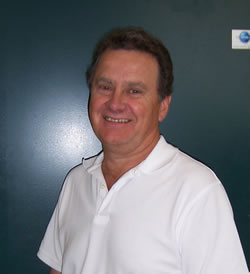 FROM OUR PRESIDENT [Top] FROM OUR PRESIDENT [Top]
Fellow Members of the OTVA,
It will not be long now before we catch up for the AGM in June. Where has the last 12 months gone?
The trip to the Telstra Museum at Bankstown was a great success. 13 OTVA enthusiasts turned up and seemed to enjoy the display of a wide variety of older telecommunications equipment, literature and other artefacts that reminded us of days gone by. The Telstra crew were really chuffed that they had the OTVA Golden Jubilee video “Memories – The OTC Story” which they played in their theatrette.
A team has been formed to continue working at the Museum in sorting and cataloguing items related to OTC. The team consist of Henry Cranfield, Bernie White, Allan Hennessy, Ray Hookway and possibly one or two other dedicated members.
Your Newsletter Editor, Bob Emanuel, is battling heavy commitments with moving residences in Paddington and maintaining his property in the Blue Mountains but is still working very hard to publish in the newsletter stories that many of you have supplied. There is a lot of work in weeding out the stuff that we are not permitted to say even 30 and 40 years after the event, not to mention correcting grammar and spelling! But that's part of the job and he loves it.
Your committee would like to see a wider range of stories submitted for consideration with respect to publication in the Newsletter. As an incentive an award of $50 will be paid to the author of the submission deemed by the committee to be the most noteworthy and interesting. Arthur Major was awarded the $50 for his article in the last Newsletter.
Your Web Master, Chris Bull, has bought a new business in Ballina but still manages to provide invaluable service in updating and maintaining the OTVA web site (http://www.otva.com). If you have not already done so check out the BLOG site where there are a few more interesting stories from Allan McPherson, John Hibbard and Keith McCredden. Allan McPherson is still awaiting some comments from his ex-colleagues in OTC Accounts Branch so don’t disappoint him.
Your committee is seeking feedback from you, the members, on how we can add more value to your lives through greater access to people and stories that relate to the many years that you enjoyed working for and with the fraternity associated with Australian & overseas telecommunications.
Unfortunately we lost a few more of our fraternity since the last Newsletter. I extend my sincere condolences to their many friends and family who are saddened by their passing but are gladdened by the fullness of their rich and long lives. May They Rest In Peace.
Warmest regards,
Peter Bull
HISTORY OF FANNING ISLAND.[Top]
by Gordon Cupit
This is, sadly, Gordon's last article as he passed away on the 15th of May. He was laid to rest on Thursday, the 27th of May. As always, contributing to the history of International Telecommunications to his last days, the article being written in March 2010. This was written to give the history of Fanning Island to Rich Smith,(a request passed on by John Hibbard), involved with the Pacific Island C.A.R.E Mission. Fanning Island is now known as Tabuaeran.
Fanning Island is in the Pacific Ocean. It is an atoll and one of the Line Islands in the Gilbert and Ellice Group. It is 228 Miles north of the Equator. Roughly oval, the island is 9.5 miles long by 6 miles wide, with an area of 8,500 acres.
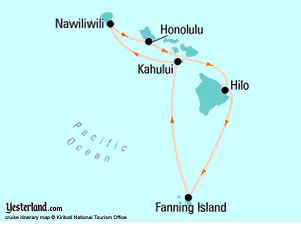
It has an enclosed lagoon having an area of 42.6 sq. Miles. The rim of the island is very low, made up of a beach crest, about 10 to 12 feet high, within, much of the land is only 2 to 3 feet above sea level. The climate although warm , is very uniform and healthy, with the mean temperature 83.5 (73 to 92) degrees Fahrenheit, modified by nearly continual trade winds. The annual rainfall is variable, but usually between 80 and 100 inches annual, with as much as 125 inches.
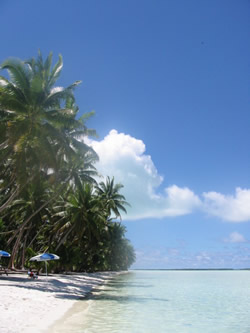
Napali Beach is one of the truly unspoiled beaches on Fanning Island.
Fanning was discovered by a Captain Fleming in 1798. Since that time, adventurers have called including French , many whalers from many nationalities, one being Father Emmanual Rougier. He had a hand in forming a Copra Company on Fanning together with nearby Washington Island. Due to low price of Copra this Company folded and sold to Burns Philp Co. Ltd, Trading under the name of Fanning Island Plantations Ltd. The Island was named by the natives as “The Place of Heavenly Footsteps.” In 1939 a link with Tonga, was described by Kenneth P. Emory, Bishop Museum Anthropologist, from ruins, adzes, a fishhook and other specimens found on the Island. He concluded that the Island was populated by people from Tonga about the fifteenth century. Being so near to the equator days and nights were the same duration. The sun rose and set in the same place each day,
A Relay Station was established in 1902 connected by cable from Bamfield on Vancouver Island to Suva Fiji. It is noted that the Bamfield-Fanning Island link is the longest continuous length in the World, 3,458 Nautical Miles, with soundings for the greater part of the route from 2,800 to 3,400 fathoms. The Suva span is 2,043 fathoms. The Station operated until 1963 , when the COMPAC cable laid. The COMPAC Cable relay directed via Hawaii.
In 1902, Fanning Island was chosen as it was a British Colony. The rest of the Pacific Cable landed on British Soil, completing the All Red Route with British Cables encircling the World. The Pacific Cable Board laid and owned the cable. The Policy of Cable routing was controlled by the Commonwealth Telegraph Union and their aim was to keep all profits within the British Empire.
The remaining British Cable Service is The Eastern and Extension and China Cable Coy. An example of this was a cable addressed to New York, would be routed via the Pacific Cable, The Terminal Charges for each relay would be charged to Australia, New Zealand, Fiji, Fanning, Canada. The rest to USA. In the case of cables to Japan, British relay stations at Darwin, Singapore and Hong Kong would get the lion’s share and Japan one portion. One exception was China who considered cables as out of date and would only work with Australia by Beam Wireless, in this case fifty percent of the terminal charge went to Australia and fifty percent to the Shanghai Radio Station. The Brits were not happy. The case of Japan, when Prime Minister Menzies visited there he agreed with the Japanese to a direct wireless link to Australia. Again upset the Brits.
The staff were trained in Sydney and could be posted to any of the relay stations from Sydney to Bamfield and later to a station opened at Norfolk Island. Postings could be up to 2 years. They were transported by Union SS Coy Ships, three trips per year. Staff were entitled to first class travel with an allowance for wine and tips. They were no wharves at Fanning and they unloaded and conveyed by lighter boats manned by native oarsmen to the Island. In heavy seas this was hazardous, especially for wives and children.
The staff of 25 who were required for shift duties, consisted of Manager, Technicians, Operators, Managers Clerk, Doctor, with Native Boatmen, Cleaners and Domestic Staff. Buildings were made of coral. Houses were provided for Staff. The supply ship was one way, proceeded on to Vancouver and went back to Sydney without calling in at Fanning. Returning staff were required to go onto Vancouver. Many decided to complete world tour and were given the cost of the ship voyage from Vancouver to Sydney. From 1931 fresh food had been supplied from Honolulu, as the Station had Refrigeration installed.
Interests were tennis, fishing, duck shooting and gardening. Land crabs were a problem and gardens had to fenced with foot high Galvanised Iron. Soil for the gardens was been imported from Honolulu. Bread fruit, bananas, figs, pineapples, taro, and arrowroot grew readily. Tomatoes had also been grown using a hydroponics method.
Boats were provided and serviced by natives. On one occasion a boat load of fishermen including an operator, Izzy Townsend, were overdue and not in sight. Fortunately, momentarily the sun shone on his spectacles and the natives went out and brought Izzy's broken motor boat back to shore.
Marine life was abundant along the reef and in the lagoon. Fanning Island is a stopping place for migratory birds from Alaska.
Indoor activities were billiards, gramophone, pianola, cards, reading and drinking. Later, comforts were radio, refrigeration, electric light (via a diesel generator),tennis, and the Library. Male staff always dressed in shorts and shirt and went barefooted. The main staple food of the natives were coconuts so The Company had to provide each member with a ration of two coconuts per day.
Coral Poisoning was the main health hazard. Iodine was used as soon as a cut or braze occurred to prevent infection. If infection occurred it was practically incurable. All staff members carried a bottle of iodine in a special pocket made for carrying the bottle. Colds, flu and other virus infections in Sydney were unknown. Mosquitoes were troublesome. In house burning Josh Sticks helped. Outside members rubbed Kerosene over all exposed parts.
There was no British Official on the island, a Representative from Gilbert & Ellice Island, issued approval for persons entering the island. He also issued Passports.
Stores and building materials went by the ship. Most of the food was tinned including Carnation Milk for the babies and infants. Bread was made locally. For Education, arrangements were made for correspondence courses to be sent by supply ship and parents attended to education between ships. One boy returning attended a leading Sydney High School and was dux of the school in his the Leaving Certificate Year. He went to University but unfortunately was killed in a road accident.
1914 a German Naval Cruiser “Nurnberg” (later sunk at The Battle of The Falkland Islands after sinking HMS Hampshire in the Battle of Coronel - Ed) slipped up to Fanning Island, flying the French Flag and wrecked the Station Building and cut the Cable, and destroyed a cache of spare instruments. No lives were lost and no prisoners taken. A native legend, Hugh Greig, (Whose father was a Scotsman who arrived in a whaling ship in 1857, and his mother was a Native, Tean Atu, sister to the then King of Manihikia), with no deep diving equipment dived in water for the ends of the cable. He buoyed each end which were joined by a piece of copper wire, kept up by barrels and pieces of wood to keep it out of the shark infested waters, together with some undamaged pieces of station and cache, from the debris, a signal was sent advising Suva of the raid. Hugh Greig received a bonus of Twenty Pounds for his feat. He lived at English Harbour, a distance of six miles He had to sail across the lagoon in an outrigger canoe. Hugh sailed single handed day or night through the channels. He was always seen holding the main sheet rope between his big and next toe, tiller arm under his arm and smoking a cigar. The Station not having equipment for joining the cable and no spare Telegraph cable, they were isolated and so a cable ship had to be sent out.
During World War II, there was a New Zealand Garrison formed in 1940. Staff Volunteers were called from Station Staff, plus a Platoon of Native Policemen with a Sergeant in charge made up a Company. Station Manager Ernie Dennis was Captain Commander, Long-un Evans Lieut. Deputy, Frank McCay Sergeant, Corporal Maurice Rees and Seven Privates. Armament was a World War I Lewis Gun and .303 Rifles. As they were usually in mufti, they carried cards advising that they were Service Personnel and covered by the rules of the Geneva Convention. This was to prevent them being executed if they were captured. Actual Service at Fanning did not entitle them to Repatriation Benefits. It is to be noted that Coastal and Island Radio members were transferred to the Navy and issued with rank and Naval Uniforms. This was to prevent beheading as was done to civilians captured in New Guinea.
Fanning Island ran out of British Currency early, which was needed to pay native staff. The Station Manager travelled to Honolulu and had Pound Notes printed by the Honolulu Star Bulletin . The Notes bore the
legend “Fanning Island Currency Redeemable at Cessation of Hostilities".
The Eastern Extension and Pacific Cable Board were merged in 1934 , the new organisation being named Cable & Wireless Ltd. Headquarters in London.
The Fanning Island Station was gained by OTC as one of the assets resulting from the OTC Act 1946. The Act provided for acquisition from AWA of its Beam Wireless and Coastal radio, and the Australian Based Assets of Cable & Wireless. This included all stations on the Pacific Chain except Bamfield in Canada.
Fanning Island was abandoned in 1963 on the completion of the Pacific Ocean Co-axial Cable
System termed COMPAC. The New Cable landing at Hawaii. The Station Building and Staff Houses were left. Most of the Instruments mainly of brass and wood were dumped in the sea.
Subsequently the University of Hawaii took over the property. A Researcher from the Institute of Geophysics that University is in charge with a large staff employed on a Tsunami Programme. An Air Strip has been constructed, it is well maintained, with buildings and a good grass Strip 4,00 0 metres long by the Pacific Equatorial Research Lab of University of Hawaii.
Vale Gordon, you will be missed by your many friends and colleagues in OTVA. We are so privileged that he recorded so much history for us to pass onto future generations.
The Fanning Island Cable Station [Top]
By Keith McCredden
I worked there for the last 2 years of its operation which closed in December 1963.
The cable station had operated since 1902 when the cable from Bamfield (Vancouver Island) was laid across the Pacific
to Fanning Island, Suva, Norfolk Island, Southport (Queensland) and on to Sydney landing at Bondi Beach.
There was a branch between Suva and Auckland and Auckland to Sydney as well.
The cable was duplicated in 1927 with a "loaded"cable which was three times the speed of the original 1902 cable. This loaded cable ran from Suva to Bamfield via Fanning Island. The 3rd channel was provided via a radio link from Sydney to Suva. The system continued across Canada and then via cables to Porthcurno UK (Near Lands End)
The Loaded cable had an inductive winding around the central core which somehow increased its speed (Comment from anyone, please as to why that happened - Ed).
From that time (1927) the cable transmission directions were switched every 12 hours so that when it was peak business hours in London the faster cable was used to send telegram traffic to Sydney and then the reverse for the Australian peak period.
The cable direction was called Fast outs/Slow homes and Fast homes/Slow outs in those good old colonial times with Home being England. This changeover to Fast outs/Slow homes was at 1am at Fanning island so the night shift person had to be on his toes at that time.
The Cable station was owned by Cable and Wireless Ltd UK however most of the staff were seconded from OTC Australia
and OTC had its own Cable Training School in Sydney based on the training given at Porthcurno.
Staffing at Fanning Island was one operator per shift 24/7 with a Cable Supervisor and a technician Monday to Friday as support.
There was also a Manager and his clerk, a Mechanical Engineer for the power and because of our isolation, Cable & Wireless
provided a Doctor as well. Labour work was done by people from the Gilbert and Ellice Islands who were recruited in Tarawa
and came to Fanning Island for a 2 or more year stay. The head of the G&E staff was a Chinese Gentleman named Tong Ting Hai,
Father of the present President of the Kiribati.
Signalling on the cable was Morse Code using a positive signal for a dot and a negative signal for a dash. This made each element the same length rather than the dash being 3 times longer than a dot as it is in normal Morse on a radio. This allowed a lot more telegram traffic to be passed in a given time. It must be remembered that the original cable was very slow compared to modern communication. In earlier days the signal had to be transcribed manually and sent on via the next section of cable. Not sure of the date but by 1927 there was automatic regeneration of the signal. The main units were the magnifiers and forks which boosted the weak cable
signal followed by the synchroniser which took its timing from the incoming signal and the interpolator which restored the signal for
retransmission. They Pacific Cable system had these two units combined into a unit know as the Synterpolator which obviously did both functions.
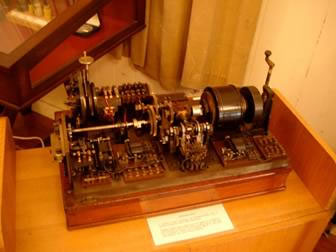
A Synterpolator - more details can now be found at the web site of the museum Keith visited at Porthcurno. Try Google.
On a trip to the UK a few years back I went to Porthcurno where the cable station is now a museum. It is run by retired cable officers who had mainly worked in the Atlantic and Mediterranean but they had never seen a Synterpolator.
I was there during the last Atomic Bomb tests at Christmas Island only 150 miles away. This was a combined US and UK test so we had observers from both countries at Fanning Island for many months.
I never want to be any closer to an atomic explosion. Just before dawn they turned night into day instantly. The fireball usually just cleared the horizon as a red dot and it took almost 30 minutes for the sound to reach us.
Telco Fraud [Top]
Collated by Bob Emanuel.
This is a collection of stories from more than a dozen telco personnel based in every region of the world over the past 20 years. These stories will fall into 3 groups - Telco Fraud, Dodgy Practices and Downright Deception.
No Telco is identified (apart from one that no longer exists in the last chapter), because to do so would besmirch the reputation of Telcos, who wouldn't like to be identified, because no company wants to admit publicly that it has been the victim of fraud.
I would love to hear more from Vets who were active in combating Telco Fraud. I know you are out there Stimmo!! Your editor welcomes your contributions on these topics.
The contributors to this story all requested anonymity, as they are still involved in the international telco business around the world. No Telco would admit to Dodgy Practices and Downright Deception, until one was well and truly caught - WorldCom.
Telco fraud occurs when a entity (an individual, groups or companies) contracts for the supply of telecommunications
services - usually telephony - with no intention of paying for those services. Long established companies as well as start-up companies fall victim to this plague. Organised crime has been involved as well as individuals and small gangs of fraudsters.
The simplest fraud is perpetrated on a start-up telco who uses Black Listing, not White Listing, in an endeavour to gain rapid market share. Competitive Telcos utilise an override code, such as 1411 in the Australia marketplace, so that customers of the incumbent Telco (quite often referred to as a PTT - Posts, Telegraph and Telephone supplier) can utilise the competitive Telco's services without a direct connection.
A White List is a list in the telephone exchanges of the start up which lists the A-numbers (or calling line identification - CLI) that are allowed to make calls on the start-up's network by using the override code. A Black List is a list in the telephone exchanges of the start-up which lists the A-numbers (or CLI) that are barred from making override code calls.
In one particular country, to drive revenue growth, the new start-up employed Black Listing and an aggressive marketing campaign to drive revenues. The pitch was that you didn't have to register, anyone could call, just dial their override code and it will cost you less.
Simple, isn't it? The best laid plans of Mice, Men and Marketing can come unstuck at anytime.
It didn't take too long for the public to work that they could get away with free calls by utilising the override code of the start-up and then ignore the bills that were sent to their address. When the start-up tried to recover the money from those customers it was so horrendously expensive to sue them all, because the bills were so relatively small, they tried to get the incumbent to bill the customers.
The incumbent Telco gleefully reminded the start-up that it was the start-up's billing problem, not the incumbent's and would the start-up kindly pay all the interconnect revenue owing to the incumbent for the provision of those unbillable calls. The start-up had to pay out money to the incumbent for interconnect charges, as well as terminating charges to the terminating telco for non-existent revenues. The start-up went to White Listing as soon as they could. Not the first Telco Marketing disaster in that country, and certainly not the last.
The most common fraud is a call-sell operation. Telephone lines are installed at the customer's premises, be they from the incumbent or the start-up; quite often the operation is a shopfront, the fraudsters then sell cheap IDD calls to a particular ethnic group and when it comes time to pay the bill, they vanish into thin air. The Telco facilitates this fraud by:
- not having any credit control checking,
- offering a 3 month billing cycle and
- a complete lack of fraud prevention/detection processes in the Telco concerned.
Some call-sell operations can also be an inside job, with the defrauded Telco's personnel involved.
One third world Telco hired a consultant who produced a simple manual process for fraud prevention and detection, as an IT system based on call records was way too costly. Some of the criteria to detect fraudulent calls were that the calls:
- would usually be made outside of business hours,
- be longer than 20 minutes to a hot destination, such as Pakistan, India and the Philippines, countries who have a large diaspora working overseas sending money back to their families.
A manual check of call records found one call of 22 minutes duration to Pakistan from the country's Stock Exchange at 1.30 on a Saturday morning. That didn't seem right to the consultant so he dug deeper.
All the call records for that night from the Stock Exchange account were retrieved and from 10pm to 6am the following morning it was seen that there were thousands of call to many destinations all less than 20 minutes and all fraudulent. Only one call had gone on for longer than 20 minutes - proof that an insider was involved.
Fortunately, that fraud was detected early. Many thousands of fraudulent calls had been made in the past few nights. The losses wiped out the IDD margin on revenues for that entire month.
Notifying the Chief Operating Officer, the consultant laid out the possibilities and suggested an investigation. The company took the matter out of the consultant's hands and did its own investigation. The consultant later found out that the telephone lines to the Stock Exchange's PABX for outbound calling had been double jumpered to an incumbent's cable which terminated at a nearby building. It turned out that a large call-sell operation was being run out of a nearby apartment. Incumbent Telco staff were involved as well the start-up's staff, but the consultant did not hear of any recriminations.
A more complicated fraud was perpetrated on a Telco by an insider who was sentenced to 7 years jail for his crime. It was a variation of the stolen credit card scam. Stolen credit card scams of various types have been with us since credit cards were invented. In the case of telephony, card users were videoed at a distance making calls at airports and railway stations, the numbers recorded on video being sold on the streets and the card company having to foot the bill for the subsequent fraudulent calls.
But one technician in a northern hemisphere Telco found that it was a lot easier to place a signalling protocol analyser onto the signalling link to an IN (Intelligent Networks) platform that provided credit card calling services. He would have that credit card information dumped onto a disc and would each working day retrieve that information onto a floppy disc and sell it to an organised crime group that was active in his city. The credit card numbers were then sold on the streets the next day. Unusually, the Telco concerned trumpeted this success far and wide as proof that it was looking after its customers.
One mobile Telco introduced pre-paid calling cards for their mobile customers, the card being decremented in value every time a call was made, until the value reached zero or close to zero. This was fine, but a card was lost and that was reported to the Telco, who barred that card. The lost cards was then found and the Telco was requested to unbar it, which it did.
Alas, for the Telco concerned, there was a bug in the card platform billing software, because that billing software was unaware that those cards had been deactivated and reactivated and so the card user got unlimited calls and in a short while many, many cards were reported lost and found until the problem was discovered and the lost-and-found cards barred. The billing software was corrected, but not before a considerable sum had been lost in outpayments to other carriers for which there was no corresponding income.
A Third World competitive telco bit off more than it could chew when it bought a company providing Public Telephones (PT's) throughout the country. The Telco management was unaware of what a lot of its technical staff knew - make a call to a 1-800 number, abuse the person answering the call, causing the B-party to hang up, then earth one side of the PT's microphone and you'd get silent dialtone and could call the world. The PT's were manufactured in Europe and the Telco had the devil's own job to get the manufacturer to fix the problem. The obvious short-term fix of barring calls to 1 800 numbers was rejected by the telco! The contributor of this item tells me it was a classic case of management not listening to its staff.
Dial-through PABX fraud is not uncommon. In this instance, a weakness in a PABX is exploited and a second dial tone is provided by a customer's PABX to an inbound call enabling a fraudster to send bulk traffic through that PABX, effectively hiding the origin of the fraudulent traffic. Conference Bridges in many new PABX's were supplied with the ability to dial out from the bridge. It was suspected, but never proved, that vendor staff were involved in some these dial-through scams.
One Telco even had the humiliation of its Head Office PABX being hacked to provide a platform for dial-through fraud one weekend. It cost them thousands.
Bankstown Museum Visit
[Top]
by Allan Hennessy
The planned visit to the Telstra museum at Bankstown was attended by 13 members of the OTVA.
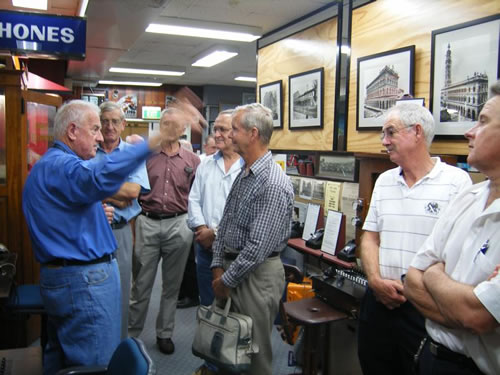
It proved to be a very interesting visit due to the well presented and wide range of equipment on display.
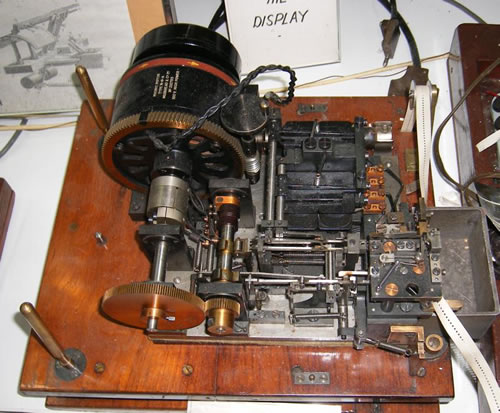
Can anyone identify this, please?
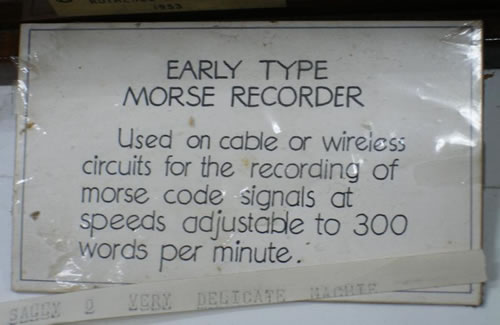
The only description the Museum has for the gear above.
The morning commenced at 10 am in the theatrette with a selected video of interest to the ex-OTC(A) members present. After the video we then moved around the passive and active displays, of a wide range of early telephone, telex, CRS telegraph and Morse based equipment. The equipment brought back memories to some of our members of years gone by in OTC.
The visit was enhanced by the professionalism and knowledge of the volunteer staff in attendance.
For those who could not make it on the day, a Wednesday only visit is recommended.
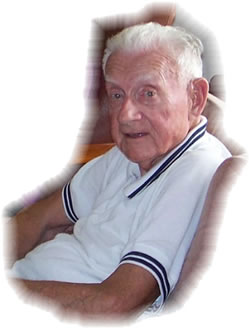 Gordon Cupit
1919 - 2010 Gordon Cupit
1919 - 2010
A wonderful memoir by David Richardson.
I first met Gordon Cupit over fifty-two years ago when, as a ‘new recruit’ to OTC, I was allocated to the Records Sub-Section to get to know the structure of the organisation, where various sections were located and how they were inter-related.
As well as becoming acquainted with the file and records systems(described by Gordon in a fairly recent Newsletter), Gordon spent time taking me through the Sydney Operating Room (on the second floor of OTC House in Spring Street), describing its operations – after all, along with outstations (both cable and coast radio) this was the core business, the ‘bread and butter’ of OTC at that time. From this time with Gordon, I gained not only a good understanding of the organisation but also, unofficially, of the various executives and their characteristics, foibles, strengths and weaknesses - invaluable to a young guy who was to spend time in the staff/personnel/ human resources area.
Gordon’s ability and knowledge were ultimately recognised by senior management when he was promoted to positions in the establishment and recruitment areas.
I am sure that there are many staff, engaged when Gordon was Recruitment Manager, who will recall his willingness to spend time explaining the intricacies of the organisation and the rights of staff Gordon also did many things outside his formal ‘duty statement’, for example, developing floor plans when sections were relocated. He was very supportive of the ‘Vets’ in its earlier days, maintaining contact with retired people and serving as OTVA President for a number of years.
After stepping down as President, he continued to be very interested in the Association’s activities and wrote occasional articles for the Newsletter. No doubt there was much factual material he could have written but which may not have been well received and which will now be lost.
Sad news indeed for those who worked with Gordon – our deepest sympathy is extended to his son Ian.
Gordon's Career, from David Richardson:
1933 - 1934 Beam Messenger, Sydney Operating Room (S.O.R.)
1934 - 1940 S.O.R. clerical duties and attended Marconi School
1940 - 1946 Australian Army including service in Records Office of 2 Military District (I think he became a Sergeant)
1946 - 1952 Telegraphist, S.O.R.
1952 - 1981 OIC Records,
Clerk (Industrial),
Recruitment Officer,
Manager (Recruitment)
3/7/1981 Retired.
Involvement with OTVA:
1953 Joined OTVA (NSW Branch)
1953-1968 Committee member
1968-1981 OTVA Secretary
1986-1997 President OTVA
John Phillips wrote these words to Gordon's son, Ian:
Dear Ian,
It was with regret that I heard the news (via the OTVA) of the passing of your Father, Gordon. Gordon was a constant source of support and advice to me as I implemented a collection of all the old OTC materials and papers when we moved across Martin Place to new offices in the MLC Building many years ago. His advice and support was crucial in later times as I implemented a proper archival system and organised the mounting of various exhibitions and displays. His memory was legendary and his record keeping meticulous – without him we would not have succeeded in rescuing as much of our historical heritage as we did. Gordon was one of the first people I sought out at our OTVA reunions, and I will miss his ready wit and constant cheer. May he rest in peace.
Ed- We will endeavour to have a full obituary published in a future edition of this wonderful man and great contributor to Australia's International Telecommunications Industry. We also await another wonderful man's obituary - RAF Taylor. It would be good if you could send us your recollections of both of these magnificent men to ediotor@otva.com
Electronic Transfer of Subs [Top]
You can use the internet to transfer your annual subscriptions - Electronic Funds Transfer. Contact Bernie White on 02 9708 4666 for details
|







 Gordon Cupit
1919 - 2010
Gordon Cupit
1919 - 2010